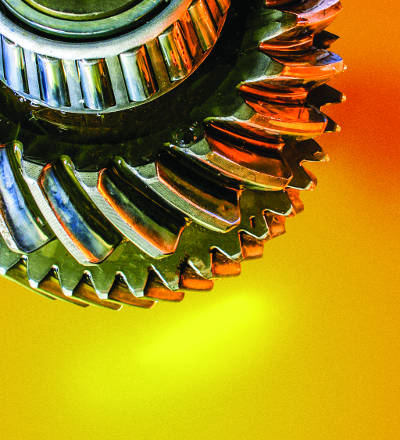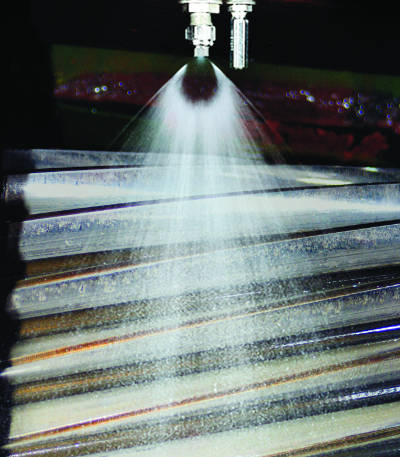As the Experts
“For gearbox applications, is it preferable to use mineral oil or synthetic oil?"
 Most gear oils use a polyalphaolefn (PAO) as a base stock. This is essentially a man-made version of the naturally occurring mineral oil pulled from the earth and refned. The size of the molecules is all relatively the same. These are also saturated molecules, which makes them very stable.
Most gear oils use a polyalphaolefn (PAO) as a base stock. This is essentially a man-made version of the naturally occurring mineral oil pulled from the earth and refned. The size of the molecules is all relatively the same. These are also saturated molecules, which makes them very stable.
The benefts of synthetic oils relate to the molecules’ stable nature and include a higher degree of hydrolytic stability and demulsibility, a higher viscosity index (VI) and a lower pour point. The VI and pour point allow these oils to perform better across a broader temperature range.
The drawbacks of synthetic oils would include their cost and solubility concerns. PAOs generally have low solubility, which means they do not dissolve additives as readily as their mineral counterparts. Synthetic oils also have a diffcult time suspending varnish-forming degradation byproducts.
While many people make the snap decision to switch to synthetic oils, the cost factor should be considered. Focus on the optimum reference state (ORS), which is the state that is best for a particular piece of equipment under its specifc operating conditions and environment. It should also take into account the equipment’s criticality as well.
For example, say you have two identical pumps with different functions in the plant and different levels of criticality. For one of the pumps, you might take vibration readings and outft it with a desiccant breather, bottom sediment and water (BS&W) bowl, and minimess sample connection. The other pump receives none of this “special treatment.” Why is that? It all comes down to a matter of cost. If the more critical pump fails, it will have a larger fnancial impact than the other pump.
This same methodology should be applied when deciding whether to use a mineral or synthetic gear oil. If the equipment’s operating conditions and environment are not as stressful or the fnancial impact of a failure would not be as signifcant, then you could probably get by with a mineral oil, as you are not likely to gain enough benefts from the synthetic oil to justify the cost. However, if the environment is more severe, the temperature runs extremely high or low, there are extended oil drains, or the impact of a failure is considerable enough to justify the cost, then you should choose a synthetic oil.
“How do you spray-lubricate an open gear? Are nozzles commonly available for this? What air pressure is ideal? What is the best distance between the nozzle and application area? Is spray lubrication the best way to lubricate an open gear?"
 When it comes to open gears, spray lubrication is a common practice. However, it isn’t the only option. A variety of greases are specially formulated to work on open gears. That said, there are some key practices to follow when using a spray system on an open gear.
When it comes to open gears, spray lubrication is a common practice. However, it isn’t the only option. A variety of greases are specially formulated to work on open gears. That said, there are some key practices to follow when using a spray system on an open gear.
As with any lubrication system, it is important to verify that the appropriate volume and type of lubricant are being used. You must also ensure that the lubricant stays in place and is of the correct viscosity.
The distance between the gear teeth and the spray system’s nozzles can vary greatly. Sometimes they may be placed as close as 2 inches, while in other cases a distance of 8 inches is desirable. It depends on the speed of the gear, the gear size and the spray nozzle in use.
A variety of nozzles are available, with each offering a distinct spray pattern and requiring a different air pressure. Selecting a spray pattern is one of the more critical considerations for this application. While most nozzles do a good job of atomizing the lubricant, you must make certain that the spray pattern coats the gear surface prior to the teeth meshing. This may require several nozzles. The entire width of the gear must be suffciently covered with lubricant, and overspray should be minimized.
It is good practice to routinely inspect any spray system for proper operation. This includes confrming that the nozzles are spraying, there is adequate air pressure and there is lubricant in the reservoir. The nozzles tend to clog with debris or wax in some cases. Any clogging of the nozzles can have adverse effects on the spray pattern and the quality of lubrication that is occurring on the gear.
Spray lubrication offers a great way to lubricate open gears, but the same rules apply as with any lubrication practice. The system will only be as good as it is installed and maintained. Many excellent systems have failed due to lack of maintenance or inspections. With proper maintenance, these systems can provide increased reliability and decrease the manpower required to lubricate the gears manually.
If you have a question for one of Noria’s experts, email it to editor@noria.com
